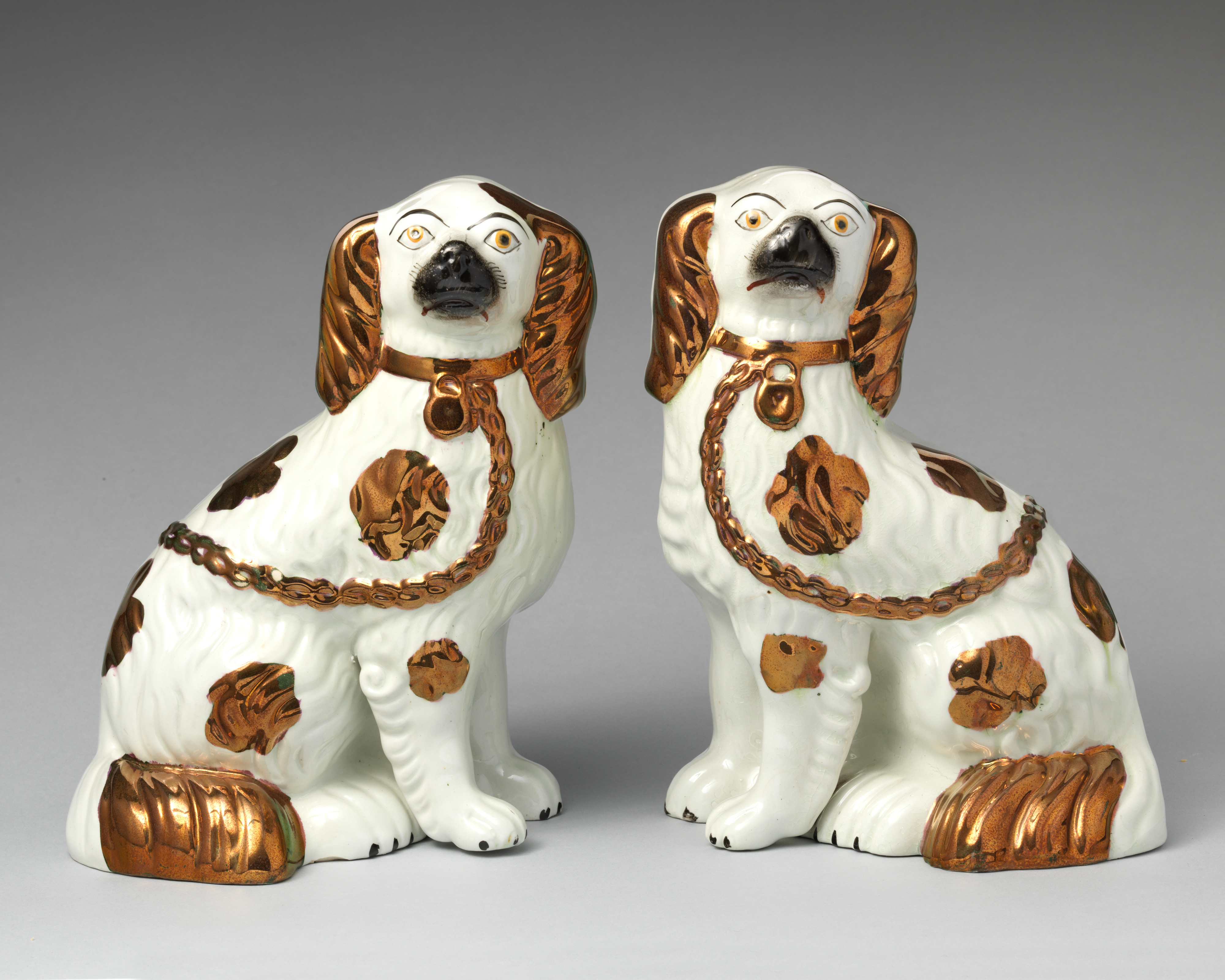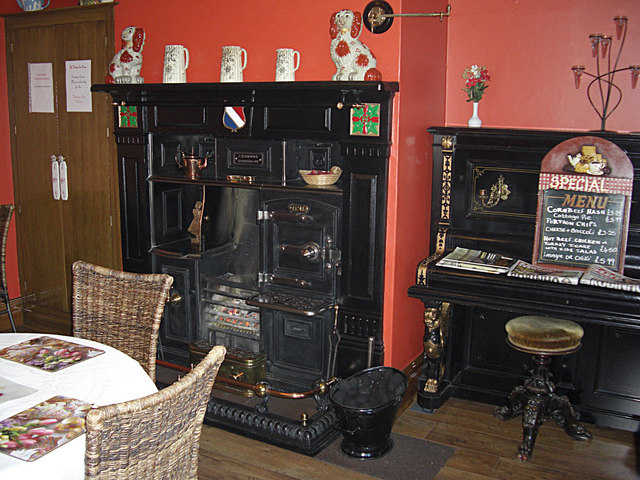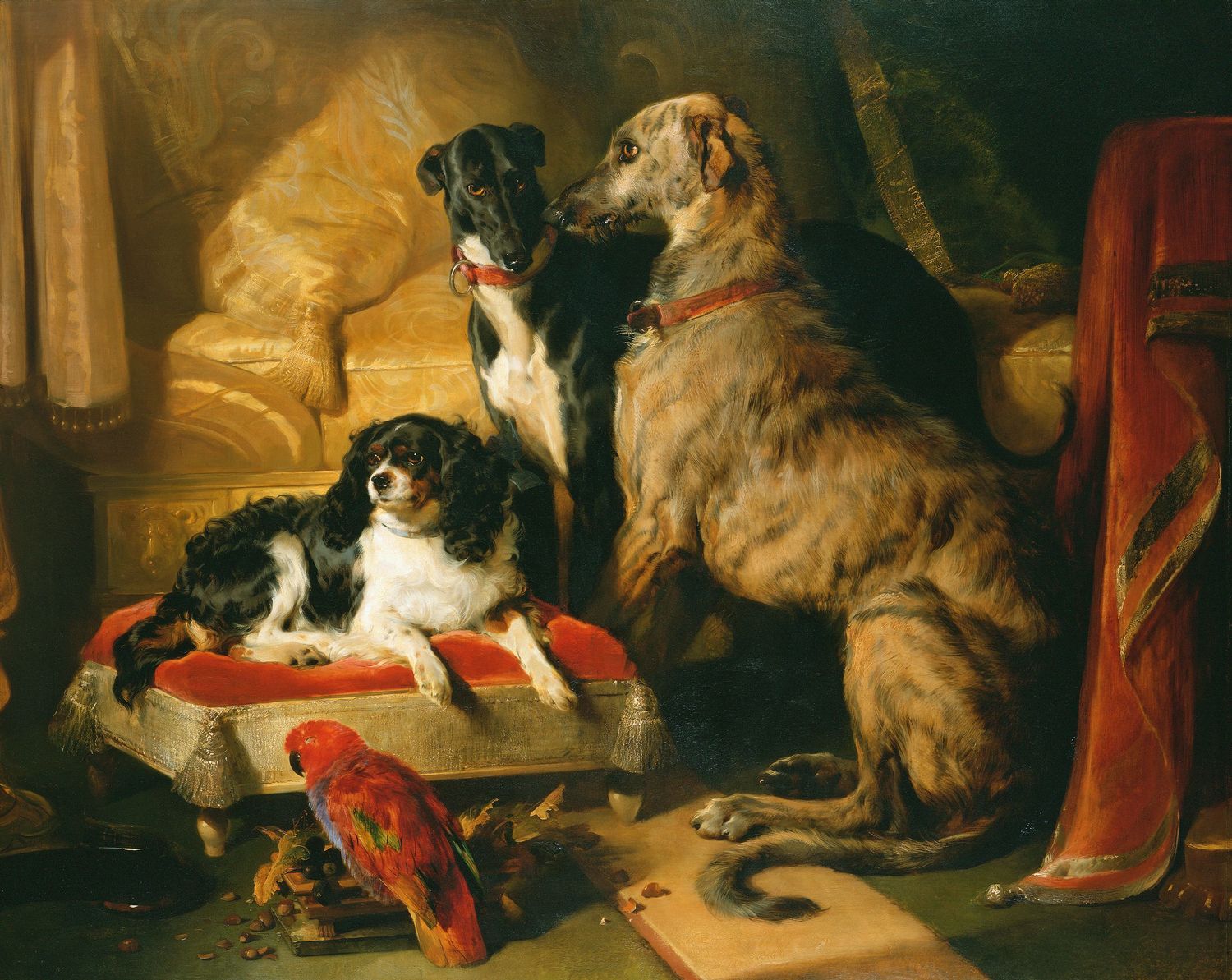Staffordshire dog figurine on:
[Wikipedia]
[Google]
[Amazon]
 Staffordshire dog figurines are matching pairs of pottery spaniel dogs, standing guard, which were habitually placed on mantelpieces in 19th-century homes. Mainly manufactured in
Staffordshire dog figurines are matching pairs of pottery spaniel dogs, standing guard, which were habitually placed on mantelpieces in 19th-century homes. Mainly manufactured in
 The spaniels were seated in pairs, decorated with a gold chain and locket, and with a creamy white base coat. The Staffordshire spaniel was the quintessential Victorian bourgeois status-symbol ornament: no mantelpiece was complete without a pair of spaniels standing guard. Staffordshire dogs were also placed on the window sill. Staffordshire dogs are nowadays collectors’ items. Since the 1720s, spaniels had been produced by pottery factories in
The spaniels were seated in pairs, decorated with a gold chain and locket, and with a creamy white base coat. The Staffordshire spaniel was the quintessential Victorian bourgeois status-symbol ornament: no mantelpiece was complete without a pair of spaniels standing guard. Staffordshire dogs were also placed on the window sill. Staffordshire dogs are nowadays collectors’ items. Since the 1720s, spaniels had been produced by pottery factories in
File:Dog MET DP-1174-027.jpg, Very early dog, c. 1745,
 The Staffordshire spaniel is tied to the history of the
The Staffordshire spaniel is tied to the history of the
 "Wally dugs" have been mentioned in Scottish poetry, including ''"The Queen of Sheba"'' by Kathleen Jamie and in a poem describing life in a Glasgow
"Wally dugs" have been mentioned in Scottish poetry, including ''"The Queen of Sheba"'' by Kathleen Jamie and in a poem describing life in a Glasgow I aye mind o' that wee hoose that stood on the brae,
Its lum was aye reekin', its roof made o' stray.
The outside was bonny, the inside was snug,
But whit I mind best o' was the wee wally dug.
It stood in a corner, high up on the shelf,
And keepit an ee on the best o' the delf.
It was washed twice a year, frae its tail tae its lug,
And pit back on the shelf, was the wee wally dug.
When oor John got mairrit tae sweet Jeannie Blue,
The auld folks they gied him a horse an' a coo,
But when I left the hoose, ma hert gied a tug,
For a' mither gied me was the wee wally dug.
There's an auld saying, 'Ne'er look a gift horse in the moo',
But I looked that wee dug frae its tail tae its broo'
An' a fun' a wee slit at the back o' its lug,
It was stuffed fu' o' notes, was the wee wally dug.
I tain it hame tae oor Lizzle tae pit on a shelf,
An' I telt her the worth o' that wee bit o' delf.
An' we aye feed it yet through that hole in its lug,
It's a guid bit o' stuff, is the wee wally dug.
The figures are also referred to as “comforters”; this is reputed to be because they could be bought outside of premises selling alcohol by husbands hoping to gain “comfort rather than conflict” from their wives.
Staffordshire dogs were described by writer Teleri Lloyd-Jones as "ornamental clichés" and depictions of the dogs have been incorporated in designs on bags and cushions.
 Staffordshire dog figurines are matching pairs of pottery spaniel dogs, standing guard, which were habitually placed on mantelpieces in 19th-century homes. Mainly manufactured in
Staffordshire dog figurines are matching pairs of pottery spaniel dogs, standing guard, which were habitually placed on mantelpieces in 19th-century homes. Mainly manufactured in Staffordshire pottery
The Staffordshire Potteries is the industrial area encompassing the six towns Burslem, Fenton, Hanley, Longton, Stoke and Tunstall, which is now the city of Stoke-on-Trent in Staffordshire, England. North Staffordshire became a centre of ce ...
, these earthenware figures were also made in other English counties and in Scotland. They are also known as hearth spaniels or fireplace dogs as they were positioned on top of the mantelpiece.
Many other breeds were produced, particularly the greyhound, though the spaniels were especially popular and this is attributed to royalty favouring the King Charles Spaniel
The King Charles Spaniel (also known as the English Toy Spaniel) is a small dog breed of the spaniel type. In 1903, the Kennel Club combined four separate toy spaniel breeds under this single title. The other varieties merged into this breed w ...
breed. In Scotland, they were colloquially termed ''Wally dugs'' and were manufactured in bulk at potteries in places such as Pollokshaws
Pollokshaws ( sco, Powkshaws) is an area on the South side of the city of Glasgow, Scotland. It is bordered by the residential neighbourhoods of Auldhouse to the east, Eastwood and Hillpark to the south and Shawlands to the north, with the Gl ...
in Glasgow
Glasgow ( ; sco, Glesca or ; gd, Glaschu ) is the most populous city in Scotland and the fourth-most populous city in the United Kingdom, as well as being the 27th largest city by population in Europe. In 2020, it had an estimated popu ...
and Portobello near Edinburgh
Edinburgh ( ; gd, Dùn Èideann ) is the capital city of Scotland and one of its 32 Council areas of Scotland, council areas. Historically part of the county of Midlothian (interchangeably Edinburghshire before 1921), it is located in Lothian ...
.
Though the most popular, the dogs were only one of many types of Staffordshire figures
Staffordshire figures are a type of popular pottery figurine made in England from the 18th century onward. Most Staffordshire figures made from 1740 to 1900 were produced by small potteries and makers' marks are generally absent. Most Victorian ...
; other animals and human figures of various kinds were also popular.
Dog figurines
 The spaniels were seated in pairs, decorated with a gold chain and locket, and with a creamy white base coat. The Staffordshire spaniel was the quintessential Victorian bourgeois status-symbol ornament: no mantelpiece was complete without a pair of spaniels standing guard. Staffordshire dogs were also placed on the window sill. Staffordshire dogs are nowadays collectors’ items. Since the 1720s, spaniels had been produced by pottery factories in
The spaniels were seated in pairs, decorated with a gold chain and locket, and with a creamy white base coat. The Staffordshire spaniel was the quintessential Victorian bourgeois status-symbol ornament: no mantelpiece was complete without a pair of spaniels standing guard. Staffordshire dogs were also placed on the window sill. Staffordshire dogs are nowadays collectors’ items. Since the 1720s, spaniels had been produced by pottery factories in Staffordshire
Staffordshire (; postal abbreviation Staffs.) is a landlocked county in the West Midlands region of England. It borders Cheshire to the northwest, Derbyshire and Leicestershire to the east, Warwickshire to the southeast, the West Midlands C ...
. The quality of the modeling and painting of the Staffordshire dogs may differ. As the popularity of the figurines increased towards the end of the 19th century, the quality began to decline. Thousands were manufactured but originals in good condition and in their correct pairs are now uncommon. The figures continued to be made until the 1920s and early models are of the better quality. However, reproductions were still being manufactured in 2009.
The spaniels come in sizes from a little over a foot to a few inches high. They were all decorated by hand, that is why all the figurines are different.
The Staffordshire mantel dog's expression can be soft or fierce, deplorable or self-satisfied, inquisitive or pleased.
The base coat is layered over with polka dots or brushed patches of rust, copper luster, or black. Disraeli spaniels feature painted curls on their foreheads; Jackson spaniels are entirely black. Some have glass eyes, some painted. The most frequent model features front legs moulded to the body; rarer models have one or two distinct front legs.
A less common group of dog figurines do have utilitarian purposes, serving also as spill vases, ring holders, banks, and jars. The mantelpiece figures came to be made in varying sizes, sometimes numbered 1 to 6 underneath, encouraging buyers to get sets ranked by size.
Children as young as seven or eight years were paid two shillings a week to paint the gold chains often included on the spaniels in the 1800s.
Spaniel figures continue to be made. In the United States, the 1952 Supreme Court case F. W. Woolworth Co. v. Contemporary Arts, Inc.
''F. W. Woolworth Co. v. Contemporary Arts, Inc.'' nicknamed ''The Cocker Spaniel Case'', 344 U.S. 228 (1952), is a United States Supreme Court case regarding copyright infringement. The Copyright Act of 1909 allows recovery of either the profits ...
concerned copyright
A copyright is a type of intellectual property that gives its owner the exclusive right to copy, distribute, adapt, display, and perform a creative work, usually for a limited time. The creative work may be in a literary, artistic, educatio ...
infringement regarding the design for a cocker spaniel
Cocker Spaniels are dogs belonging to two breeds of the spaniel dog type: the American Cocker Spaniel and the English Cocker Spaniel of which are commonly called simply Cocker Spaniel in their countries of origin. In the early 20th century, Cock ...
figure.
Similar dog figures were made elsewhere - the early Staffordshire examples often imitated types they knew from Chinese export porcelain
Chinese export porcelain includes a wide range of Chinese porcelain that was made (almost) exclusively for export to Europe and later to North America between the 16th and the 20th century. Whether wares made for non-Western markets are covered b ...
, and the Staffordshire types were exported to and eventually imitated by other English-speaking markets. But the mantelpiece pair as an iconic feature remained a British phenomenon.
salt-glazed
Salt-glaze or salt glaze pottery is pottery, usually stoneware, with a glaze of glossy, translucent and slightly orange-peel-like texture which was formed by throwing common salt into the kiln during the higher temperature part of the firing pro ...
stoneware
Stoneware is a rather broad term for pottery or other ceramics fired at a relatively high temperature. A modern technical definition is a vitreous or semi-vitreous ceramic made primarily from stoneware clay or non-refractory fire clay. Whether vi ...
, c. 8.5 inches tall
File:Pair of Chinese dogs of Foo MET DP-12529-005.jpg, Early pair, c. 1750, copying Chinese figures. salt-glazed
Salt-glaze or salt glaze pottery is pottery, usually stoneware, with a glaze of glossy, translucent and slightly orange-peel-like texture which was formed by throwing common salt into the kiln during the higher temperature part of the firing pro ...
stoneware
Stoneware is a rather broad term for pottery or other ceramics fired at a relatively high temperature. A modern technical definition is a vitreous or semi-vitreous ceramic made primarily from stoneware clay or non-refractory fire clay. Whether vi ...
, c. 8.5 inches tall
File:Staffordshire pottery creamware spaniel on cushion, circa 1780.jpg, Creamware
Creamware is a cream-coloured refined earthenware with a lead glaze over a pale body, known in France as '' faïence fine'', in the Netherlands as ''Engels porselein'', and in Italy as ''terraglia inglese''.Osborne, 140 It was created about 175 ...
, c. 1780
File:Dog figurine pen holders, Staffordshire, England, c. 1825-1840, glazed earthenware - Montreal Museum of Fine Arts - Montreal, Canada - DSC09321.jpg, Greyhound pen-holders, c. 1825-1840
File:Nantclwyd y Dre, Rhuthun, Sir Ddinbych 04.JPG, On a mantelpiece
File:Staffordshire hond.tif
File:Unusual recumbent Staffordshire spaniel figure, circa 1860.jpg, Less common recumbent figure, c. 1860
File:Figure (AM 1923.20-1).jpg, Before 1923, with gold chain.
File:Dog Figure, 1741 (CH 18381739) (cropped).jpg, German Meissen porcelain
Meissen porcelain or Meissen china was the first European hard-paste porcelain. Early experiments were done in 1708 by Ehrenfried Walther von Tschirnhaus. After his death that October, Johann Friedrich Böttger continued von Tschirnhaus's work an ...
dog, 1741
File:Spaniel, Rockingham Pottery, Bennington VT, 1850-1900, mold-cast stoneware with manganese mottled brown glaze - Krannert Art Museum, UIUC - DSC06649.jpg, American spaniel, Rockingham Pottery, Bennington, Vermont
Bennington is a town in Bennington County, Vermont, United States. It is one of two shire towns (county seats) of the county, the other being Manchester. As of the 2020 US Census, the population was 15,333. Bennington is the most populous t ...
, 1850-1900
King Charles Spaniel
 The Staffordshire spaniel is tied to the history of the
The Staffordshire spaniel is tied to the history of the King Charles Spaniel
The King Charles Spaniel (also known as the English Toy Spaniel) is a small dog breed of the spaniel type. In 1903, the Kennel Club combined four separate toy spaniel breeds under this single title. The other varieties merged into this breed w ...
. These spaniels became great favourites of the British monarchs. King Charles I (1600–1649) had a spaniel as a young boy. Owing to Queen Victoria
Victoria (Alexandrina Victoria; 24 May 1819 – 22 January 1901) was Queen of the United Kingdom of Great Britain and Ireland from 20 June 1837 until her death in 1901. Her reign of 63 years and 216 days was longer than that of any previ ...
’s spaniel Dash
The dash is a punctuation mark consisting of a long horizontal line. It is similar in appearance to the hyphen but is longer and sometimes higher from the baseline. The most common versions are the endash , generally longer than the hyphen ...
(1830-40), however, the spaniel model enjoyed a surge in popularity in the 1840s which lasted through her reign.
Not all dog models were based solely on the spaniel. You can also find other Staffordshire dog breeds, such as pugs, afghans, greyhounds, collies, poodles, and Dalmatians.
Common names
 "Wally dugs" have been mentioned in Scottish poetry, including ''"The Queen of Sheba"'' by Kathleen Jamie and in a poem describing life in a Glasgow
"Wally dugs" have been mentioned in Scottish poetry, including ''"The Queen of Sheba"'' by Kathleen Jamie and in a poem describing life in a Glasgow tenement
A tenement is a type of building shared by multiple dwellings, typically with flats or apartments on each floor and with shared entrance stairway access. They are common on the British Isles, particularly in Scotland. In the medieval Old Town, i ...
.
There is a popular Scottish poem by an unknown author dedicated to "The Wally Dug". It reads:The meanings of some of the less common Scots words are: aye-always; brae-hill; lum-chimney; reekin'-smoking; stray-straw; ee-eye; lug-ear; delf-earthenware; gied-gave; moo'-mouth; broo'-brow; fun'-found.
Enid Marx
Enid Crystal Dorothy Marx, RDI (20 October 1902 – 18 May 1998), was an English painter and designer, best known for her industrial textile designs for the London Transport Board and the Utility furniture Scheme. Marx was the first female eng ...
’s still life painting ''"Still life with Staffordshire Dog and tulips"'' was motivated by her white Staffordshire Wally Dug. Various examples of Staffordshire dog figurines were included in the Marx-Lambert collection, which was put on display at Compton Verney House
Compton Verney House () is an 18th-century country mansion at Compton Verney near Kineton in Warwickshire, England. It is located on the west side of a lake north of the B4086 about north-west of Banbury. Today, it is the site of the Compton ...
in 2004.
Victorian fairy tale
There are various tales said to portray the usefulness of placing the Staffordshire spaniel figurines on window sills. One story is that a woman could place the ornaments in her front window; if the spaniels were turned back to back, it meant her husband was at home. If he was away or at sea, the dogs would be placed facing each other. When her lover passed the house, he would then know by the way the dogs were facing, whether it was safe for him to visit her without her husband knowing. This story is also re-capped in the Baltic.Notes
References
{{Decorative arts Scottish pottery Staffordshire pottery Dogs in art Spaniels dog